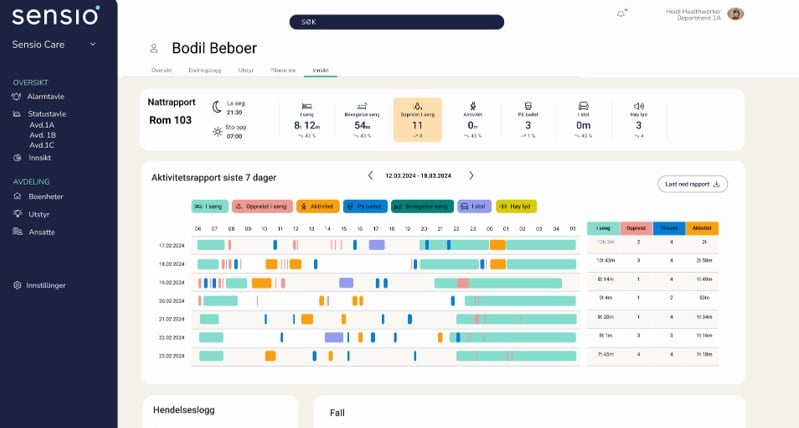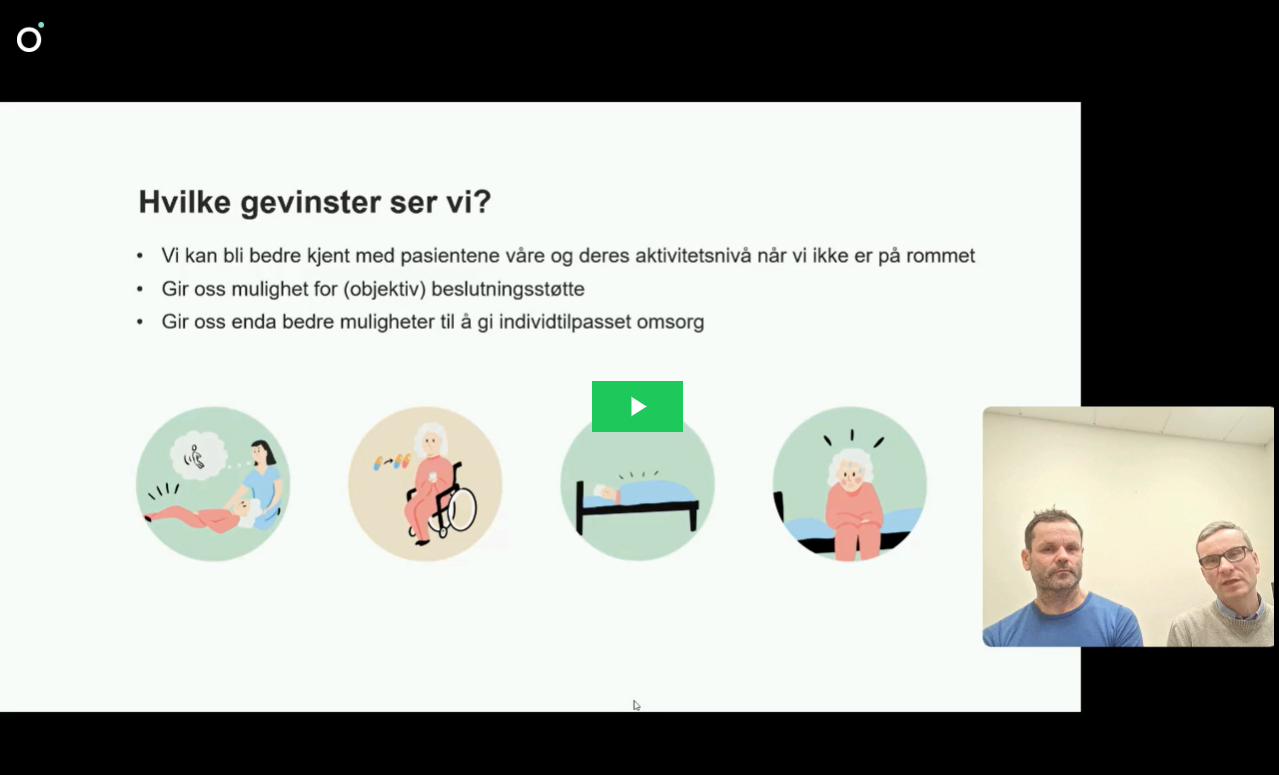Nesoddtunet care home uses sensor data to provide better personalised care
As a pilot customer for the award-winning Sensio Insight e-health solution, Nesoddtunet care home is using sensor data to map residents' daily activities and needs. The goal is clear: better mapping of residents, faster identification of health risks and more individualised care.
 Nesoddtunet care home is a large care home spread over three buildings, with 122 resident rooms, 9 units and 300 employees. The care home is no stranger to using care technology and is a forward-looking care home where the care teams are comfortable using digital solutions in their everyday work to create more time for care. They do this by using RoomMate and Sensio 365, among other things.
Nesoddtunet care home is a large care home spread over three buildings, with 122 resident rooms, 9 units and 300 employees. The care home is no stranger to using care technology and is a forward-looking care home where the care teams are comfortable using digital solutions in their everyday work to create more time for care. They do this by using RoomMate and Sensio 365, among other things.
Since September 2024, Nesoddtunet has also been piloting Sensio Insight. This solution uses sensor data to map individual behavior and uses this to provide better decision support to care teams and assist in providing more person-centered care.
The solution has been developed in collaboration with several Norwegian local authorities and won the EHiN awards in 2024.
How Nesoddtunet care home introduced Sensio Insight
Nesoddtunet first started using Insight on the short-term unit, but with a limited number of residents they wanted to map better. This was important for the care teams to become confident in the solution before it was rolled out to the rest of the short-term unit in November 2024.
They had weekly meetings with Sensio, where both nurses and doctors participated in some of these. This was both so they could get to know the solution better, but also so that the Sensio Insight team could learn from Nesoddtunet care home's use and their feedback.
Sensio Insight in practice
 In our webinar in January 2025, Stig Henning Morken (left in the picture), Advisor and Project Manager at Nesodden local authority, and Department Manager Konrad Dawda (right in the picture) from Nesoddtunet care home, shared three examples of how they have used Sensio Insight to gain better insight into residents' behavior and initiated measures based on this.
In our webinar in January 2025, Stig Henning Morken (left in the picture), Advisor and Project Manager at Nesodden local authority, and Department Manager Konrad Dawda (right in the picture) from Nesoddtunet care home, shared three examples of how they have used Sensio Insight to gain better insight into residents' behavior and initiated measures based on this.
Example 1 - From bed to increased activity
A resident who had suffered a stroke and had aphasia was admitted. The resident was perceived as active as she always came out for meals and was observed in the hallway by care teams. However, when the teams looked in Sensio Insight, they discovered that she was not as active as they thought. It turned out that she often went back to bed after meals and spent a large part of the day in bed.
The Sensio Insight report was then used to make care teams aware of the problem. They took steps to ensure that the resident did not return to bed during the day and became more active.
Example 2 - Restlessness reveals infection and concerns
A new resident with cognitive impairment arrived at Nesoddtunet care home and had experienced several falls and fractures in the past. The report from Sensio Insight indicated that the resident was experiencing a lot of agitation, she was up in bed a lot during the night and seemed to be unable to calm down.
Based on this information, an examination was carried out which revealed a urinary tract infection, and the resident was started on treatment for this. It helped with the anxiety. The resident also expressed that she was afraid of being in a care home, which they then informed her relatives about and initiated measures in collaboration with them to reassure her about being in a care home. As a result, the resident was able to calm down and her sleep quality improved as she was no longer very active at night.
Example 3 - High risk of falls, taking preventive measures
The resident came to the care home and had experienced repeated falls and hip fractures. The person had cognitive impairment and did not want to use assistive devices/call for help. The report from Sensio Insight showed a lot of restlessness at night and that she was up in bed a lot during the night. The resident was therefore given a hip protector to reduce the likelihood of a fracture and the care teams were made aware of disturbances at night, so they could be extra aware and rather have more supervision to reduce the risk of falls.

Benefits with Sensio Insight
Nesoddtunet has now been using Sensio Insight for several months and they summarize the webinar by sharing three benefits they have seen so far.
-
They get to know their residents and their activity level even better
Nesoddtunet sees that this can help them get to know their residents and their activity level better, even though they are not in the room. It gives them a better knowledge and overview, which helps them map residents better and detect changes much faster.
-
Gives them objective decision support
It gives them better objective decision support. Instead of relying solely on mapping written by the nurse's subjective assessment, they also get objective data from the RoomMate sensor. In this way, Nesoddtunet now has the opportunity to make qualitatively better decisions.
-
They get a better opportunity to provide individualised care
Sensio Insight gives them a better overall picture of the resident's needs, making it easier for them to provide individualised care.
In the future, Nesoddtunet plans to introduce Sensio Insight in several units, introduce Insight in interdisciplinary meetings and make Insight part of the employees' work routines. The collaboration between Sensio and Nesoddtunet also continues, and we are working closely with Nesoddtunet to look at opportunities to further develop Sensio Insight.
Watch the full webinar here (Norwegian) for an introduction to Sensio Insight and better insight into how it has worked at Nesoddtunet care home.
Are you interested in learning more about Sensio Insight? Contact us via the form on the Sensio Insight page here!
